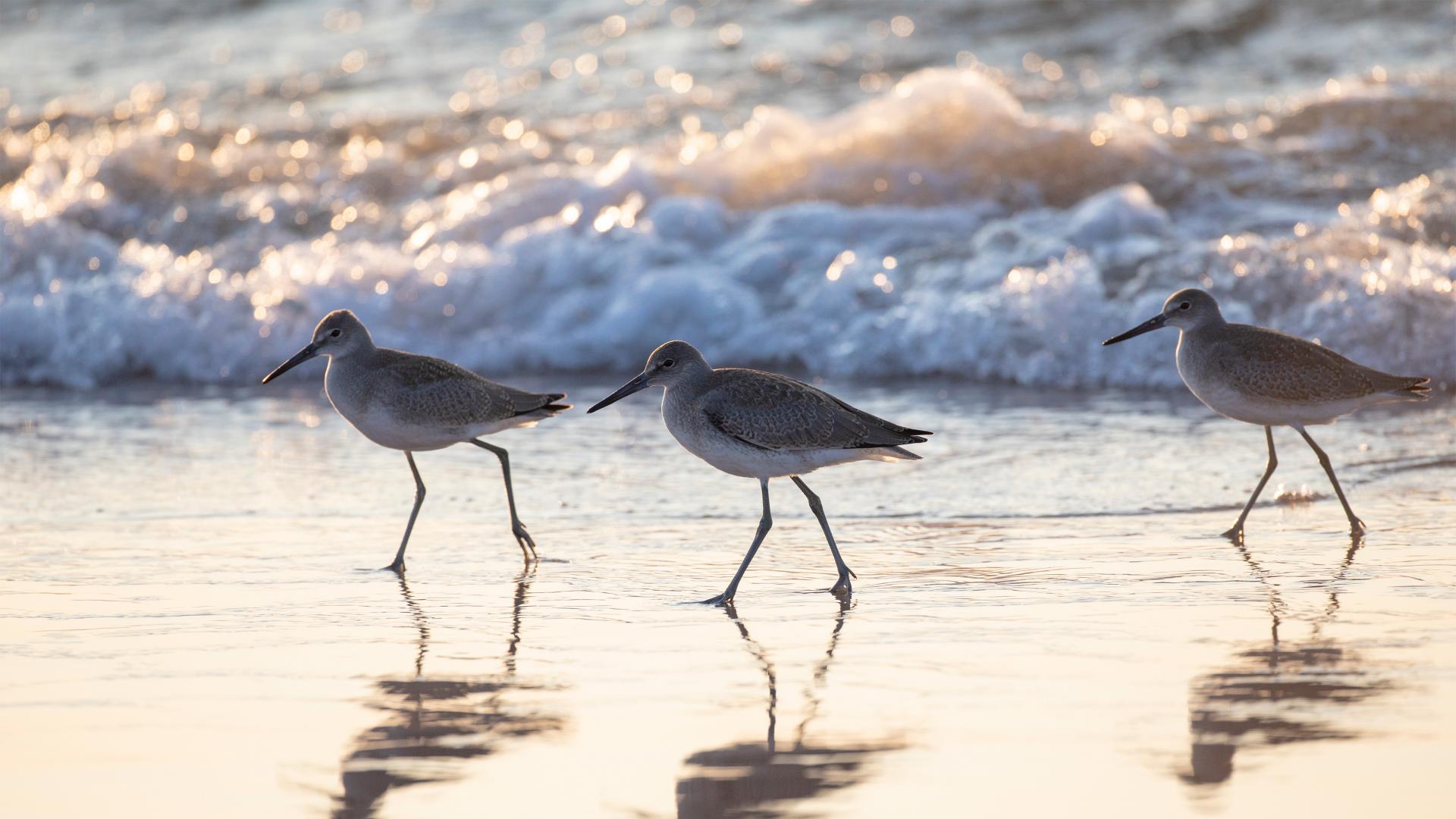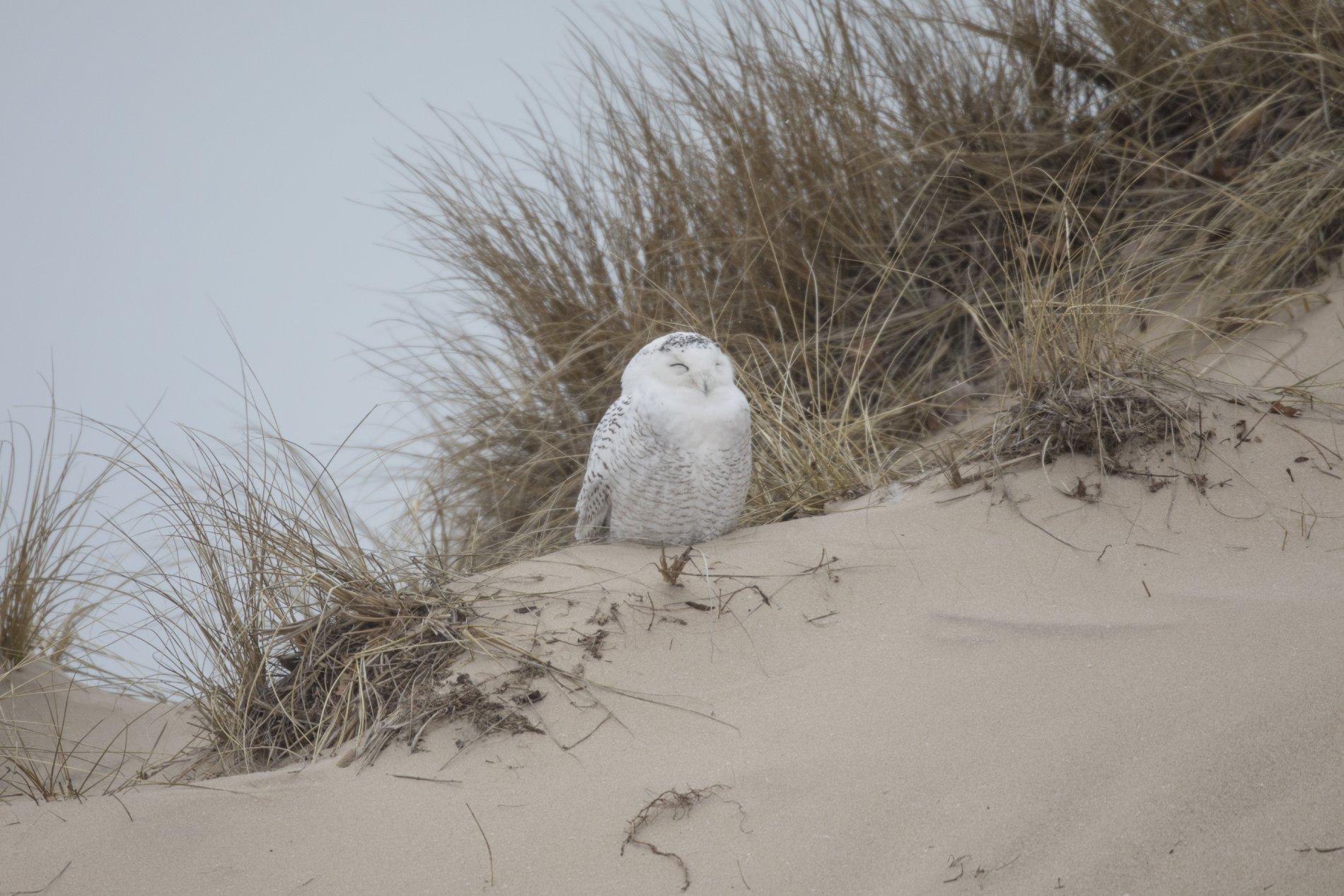Tips for birdwatching in Southwest Michigan

The number and diversity of birds in Southwest Michigan make it a great birding destination. You can find songbirds, raptors, waterfowl, and shorebirds in this region’s wide range of habitats, including dunes, forests, wetlands, meadows, agricultural lands, and numerous bodies of water. Moreover, many migratory birds follow Lake Michigan's shoreline so you can have exciting sightings in the spring and fall.
A LOW-COST OUTDOOR ADVENTURE
You can bird-watch anywhere and at any time. Watch the birds at bird feeders at our nature centers, while hiking or biking our trails, kayaking or fishing on our lakes and rivers, and even as a passenger in a car. There’s little cost to enjoying this sport besides an occasional park admission and the optional purchase of binoculars. Buying binoculars with expensive lenses can help you see better, but save money when you try bird-watching.
Another great thing about birding is that you can do it alone or with family and friends. The time outdoors makes you more aware and appreciative of the diversity of our natural areas and how critical they are to wildlife. It’s also good for uplifting your spirits when you hear birds singing and calling from the trees, meadows and sky.
TOP 5 BIRDING LOCATIONS
FERNWOOD BOTANICAL GARDEN | NILES
Fernwood offers a rich and diverse bird-watching experience throughout its varied habitats, including forests, wetlands, prairies, an arboretum and meticulously maintained gardens. With 177 species recorded, it's a haven for casual birders and ornithologists. The Sims Education Center and the Nature Center, featuring bird feeding stations, are year-round attractions, drawing an array of bird species.
Early Spring at Fernwood is particularly thrilling, marking the return of ruby-throated hummingbirds, Baltimore orioles, rose-breasted grosbeaks, and indigo buntings. The gardens are home to wild turkeys, eastern phoebes, house wrens, chipping sparrows, song sparrows, and cardinals. The area along the St. Joseph River offers sightings of great blue herons, kingfishers, and winter ducks such as mergansers, bufflehead, and common goldeneye.
Fernwood's forests resonate with the calls of scarlet tanagers, yellow-throated vireos, wood thrushes, and Acadian flycatchers during the breeding season. The tallgrass prairie is a spot to enjoy common yellowthroats and goldfinches, while a stroll through the Arboretum could reveal bluebirds, field sparrows, brown thrashers, and indigo buntings.
Birders can see along the St. Joseph River, rare birds like the common loon, bald eagle, osprey, and prothonotary warbler, all classified under varying conservation statuses. The wet forests of Fernwood shelter red-shouldered hawks, cerulean warblers, yellow-throated warblers, and hooded warblers, all considered threatened or of special concern. The tallgrass prairie is sometimes graced by the presence of dickcissels.
LOVE CREEK COUNTY PARK & NATURE CENTER | BERRIEN CENTER
Set in the serene surroundings, Love Creek County Park & Nature Center is an exceptional birding destination with varied upland habitats, including mature beech-maple forests. Love Creek weaves its way through the 200 acres, offering bird watchers a unique blend of natural landscapes to explore.
During different seasons, bird enthusiasts can spot a range of species. The wooded stream ravines are home to Acadian Flycatchers and Louisiana Waterthrushes which nest in the area. The park’s dense beech-maple forests make it an ideal habitat for pileated woodpeckers, often seen here.
Besides forested areas, Love Creek includes old field habitats where white-eyed vireos and yellow-breasted chats appear in some summers. The nature center building features large windows for observing many woodland birds at the feeders.
With over five miles of hiking trails, Love Creek offers access to various habitats, enhancing the birding experience. The park’s observation platforms present birders with strategic viewpoints to observe avian life in its natural setting.
Love Creek County Park sponsors the Berrien Birding Club, making it a great spot to gather local birding information and learn about upcoming birding events. The park also offers mountain and fat tire biking and cross-country skiing, making it a four-season favorite for combining bird-watching with outdoor recreation.
SARETT NATURE CENTER | BENTON HARBOR
This is a bird-watcher’s paradise. Sarett Nature Center provides extraordinary opportunities for birding with over eight miles of trails, boardwalks, observation platforms and the unique Tree Top Walkway. Its diverse medley of habitats, including inland forests, wetlands, and agricultural areas bordered by Lake Michigan, contributes to the sighting of over 300 species in Berrien County.
In spring and early summer, Sarett is alive with the vibrant colors and songs of prothonotary warblers along the Paw Paw River and orchard orioles near the entrance. The pine plantation across from the entrance and the cedars along the trail below the interpretive center are winter havens for Northern Saw-whet and long-eared owls. Prairie areas along Benton Center Road, south of the entrance, offer sightings of terns, bobolinks, dickcissels, grasshopper sparrows, and occasionally Henslow's Sparrows in the summers.
Birders can explore the many trails, especially during migration periods, for a variety of species. The Treetop Tower Trail offers eye-level views of birds in the forest canopy, providing a unique perspective and an immersive birding experience.
The nature center's commitment to environmental education, with programs like pond study, maple sugaring and river exploration, enhances the birding experience. Regular birding classes, day-long adventures to local hot spots, and participation in bird surveys make this a must-visit on any birder’s itinerary in Southwest Michigan.
TISCORNIA BEACH | ST. JOSEPH
This picturesque, 16-acre family-oriented park on Lake Michigan’s shoreline is a splendid location for bird-watching. On the City of St. Joseph’s northwest corner, the park's sandy beach, North Pier Lighthouses, fishing walkway, picnic pavilion and restroom facilities, make it one of the most comfortable and enjoyable bird-watching destinations for families and enthusiasts. Its sandy beach and pier provide unique vantage points for observing avian life, especially during the golden hours of sunrise and sunset.
In spring, birdwatchers can spot the common loon, various grebes, the red-breasted merganser, the double-crested cormorant, American Coot, along with different plovers, sandpipers, gulls, and terns. This season marks the return of many migratory birds, providing a lively birding experience.
Summer at Tiscornia Beach brings unique shorebirds like the American Avocet, Baird’s Sandpiper, willet, marbled godwit, red knot, and sanderling. Occasionally you may see laughing, Franklin’s, and little gulls, too..
Fall witnesses the return of the common loon, various ducks, gulls, and the common tern. Birders may also catch rare sightings of the purple sandpiper, red phalarope, and black-legged kittiwake.
Winter transforms the park into a haven for ducks such as bufflehead and common goldeneye, different gull species, and the majestic snowy owl, offering a unique birding experience against the serene winter backdrop.
WARREN DUNES STATE PARK | SAWYER
Along the scenic shore of Lake Michigan, this park is an extraordinary bird-watching location! Its 1,952 acres include forested dunes, open dunes (some towering up to 260 feet above the water), and interdunal wetlands. The park's proximity to the lake makes it a pivotal stopover for birds during migration, particularly along the lake's shoreline.
In spring, the park becomes a hotspot for raptor enthusiasts, with eight or more species, including various hawks and eagles, observed passing overhead. This period also welcomes flocks of sandhill cranes, offering a splendid spectacle for birders. May marks the peak for migrant songbirds, transforming the park into a symphony of bird calls and vibrant plumage.
The park’s breeding species add to its allure. Birdwatchers can spot an array of nesting birds such as wild turkey, red-headed and pileated woodpeckers, Least Flycatcher, veery thrush, pine warbler, back-throated green warbler, Canada Warbler, vesper sparrow and the vivid scarlet tanager.
Warren Dunes, along with nearby Warren Woods State Park, are unique breeding grounds for several "southern" species uncommon in most of Michigan. This includes the Acadian Flycatcher, white-eyed vireo, Carolina Wren, worm-eating warbler, Louisiana Waterthrush, prothonotary warbler, hooded warbler, prairie warbler, and summer tanager.
The park's varied terrain, from its extensive shoreline and hiking trails to its high dunes, offers outstanding birding opportunities and stunning panoramic views. The combination of its unique geographical features and role as a migration stopover makes Warren Dunes State Park an exceptional and popular destination to add to any birder’s bucket list.
BIRDWATCHING TIPS
- Be patient, be quiet and avoid sudden movements.
- Wake up early. Birds are generally very active and vocal in the morning.
- Look for locations where birds can find both food and water.
- Try places where two habitat types meet; forest and wetland, water and shoreline, etc.
- Visit a variety of locations. Different birds favor different habitats.
- Pay attention to the changing seasons. You may only see some birds in the summer, others only in the winter, and others only briefly during migrations.
- Go birding after a windstorm. Powerful winds can transport birds long distances. It is a great opportunity to see birds not usually in our area.
- Wear earth tones to help blend into the background. You do not need to wear camouflage, but the goal is to avoid large contrasts with the surrounding landscape.
- Always be looking. When you start to notice the birds around you, you may be surprised at how many there are.
- When observing flocks of birds closely, you may spot a bird that doesn't seem to belong. For example, in the spring and fall, there have been sightings of unusual birds mingling with groups of gulls on the beach.
- Pay attention to details. There are sometimes only subtle differences between different birds.
- Use your ears along with your eyes. Learning bird calls can open up a whole new appreciation of birds and make it easier to identify them especially if they are difficult to spot.
- Get to know your local birds. This will help you notice when a different species is in the area.
- Keep a journal. Writing a list of where and when you see birds will help you learn their seasonal patterns and the locations where you are more likely to find them.
- Talk with other birders. They can give tips on great places to look and help with identification.
- Buy or borrow a birding guide or download an app to help you identify birds.
- Get a pair of binoculars or a spotting scope to see further and with more detail.
- Bring a camera, if you cannot identify a bird, take a photo and look up information later.
For more information, check out the Berrien County Birding Destinations Map or contact a local nature center like Fernwood Botanical Garden and Nature Preserve.
STAY FOR MORE THAN A DAY
After bird-watching in Southwest Michigan’s splendid natural landscapes, indulge in the local flavors at renowned restaurants, wineries, breweries, distilleries, and cideries. Don’t forget to check out the local events calendar, as the region is bustling year-round with festivals, live music, and cultural happenings.
Then, extend your stay at one of the area's comfortable hotels, ensuring ample time to explore and relax. Your birdwatching adventure in Southwest Michigan is just the beginning of what this vibrant area offers!
Share with Us
Please send us photos and videos of your Southwest Michigan getaway. Use our hashtag #swmichigan or upload your photos to our content collector below. This is an opportunity for your photos to appear on our social media, website or marketing materials. Thanks for sharing your memories!









